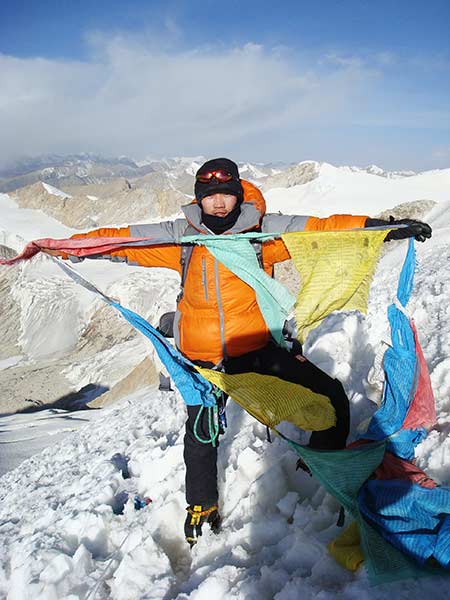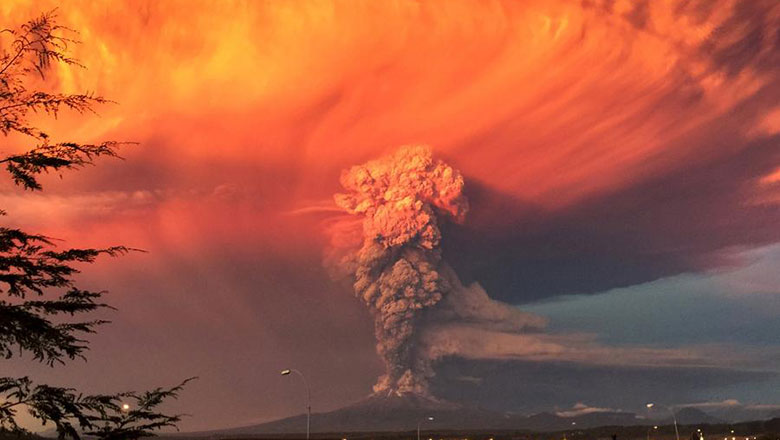Ascent of sacred mountains acts as a new form of worship
Updated: 2015-12-29 08:15
By Palden Nyima and Da Qiong in Lhasa(China Daily)
|
||||||||
 |
|
Tsering Tandar hangs Buddhist prayer flags on a 6,200-meter peak in Tibet in 2009. CHINA DAILY |
Most Tibetans regard high, snow-capped mountains as sacred and they have long tradition of honoring them by making religious offerings or circling the base on foot.
Tsering Tandar climbs them instead. He regards the trek to the summit as a different way of worship.
"Climbing gives me the opportunity to feel those sacred mountains closely, and I regard it as a new way to pay my homage to them," said Tsering, a 28-year-old mountaineer.
"Some Tibetans have asked me why I climb the mountains, and they felt it was a strange thing to do," he said. "The social transformation has brought new thoughts to the Tibetan people, and many Tibetans no longer think it is wrong to climb the sacred mountains."
An early graduate of the Tibet Mountaineering School and a member of the Tibet Mountaineering Team, Tsering is eager to attract more people to the rigors and joys of climbing the world's tallest mountains.
Although mountaineering may do a little harm to the fragile environment, it makes a great contribution to the region's social development, Tsering said.
Raising awareness of environmental protection during mountain climbs is one of his goals, and he counsels climbers from outside not to cook meat as Tibetans believe such actions near sacred mountains will aggravate the gods and pollute the air.
To care for the environment, the Tibet Mountaineering Team regularly organizes volunteers to clear the area around Qomolangma, known as Mount Everest in the West.
"Mountaineering can lead to the region's economic growth, and the people near those mountains are direct beneficiaries as well," Tsering said.
Besides working at the mountaineering school, where he teaches Chinese, English and geography, and as a coach on the mountaineering team, Tsering is in his third year of postgraduate work in communications at the China University of Geosciences in Wuhan.
In addition to climbing, Tsering loves photography. He was one of the six photographers covering the torchbearers on Mount Qomolangma in celebration of China's 2008 Olympic Games.
Whenever there is mountaineering or outdoors activity in Tibet, Tsering posts the news on WeChat, a popular messaging app. Through his efforts, he said the number of participants at the mountaineering school's activities has increased from about 40 to 60.
"Many people, especially Tibetans, are unfamiliar and are afraid of the sport," he said. "I want to promote the activities to help more Tibetans get to know about mountaineering."
Tsering has conquered more than 30 mountains over the past 10 years, including six mountains on seven continents, and the world's highest peak, Qomolangma.
One of his proudest accomplishments was hanging colorful Buddhist prayer flags at the peak of a high mountain, as Tibetans believe they accumulate good luck by hanging the prayer flags - symbolizing luck, happiness, compassion, prosperity, health and longevity - atop the highest mountains.
Although Tsering was thrilled and excited when he first reached the summit of a high mountain, he was afraid of climbing down. Because mountaineering is dangerous, he and his fellow climbers gather to pray before they start a climb.
"The prayer ceremony gives us courage and faith, and most climbers join the activity no matter if they are religious or not," he said.
- US-led air strikes kill IS leaders linked to Paris attacks
- DPRK senior party official Kim Yang Gon killed in car accident
- Former Israeli PM Olmert's jail term cut, cleared of main charge
- Japan, S. Korea reach deal on 'comfort women'
- More than 70 killed in Nigeria bombings, suicide attacks
- Argentina issues orange alert for heat wave

 Yearender: Chinese athletes of year
Yearender: Chinese athletes of year
 Yearender: Key words from popular China news stories in 2015
Yearender: Key words from popular China news stories in 2015
 Hangzhou shuts steel plant to improve air quality
Hangzhou shuts steel plant to improve air quality
 China's longest tunnel under lake open to traffic
China's longest tunnel under lake open to traffic
 Top 10 policy changes in China in 2015
Top 10 policy changes in China in 2015
 Yearender 2015: Natural disasters
Yearender 2015: Natural disasters
 The world in photos: Dec 21 - 27
The world in photos: Dec 21 - 27
 Yearender: Film critics' top 10 Chinese films of 2015
Yearender: Film critics' top 10 Chinese films of 2015
Most Viewed
Editor's Picks

|

|

|

|

|

|
Today's Top News
Shooting rampage at US social services agency leaves 14 dead
Chinese bargain hunters are changing the retail game
Chinese president arrives in Turkey for G20 summit
Islamic State claims responsibility for Paris attacks
Obama, Netanyahu at White House seek to mend US-Israel ties
China, not Canada, is top US trade partner
Tu first Chinese to win Nobel Prize in Medicine
Huntsman says Sino-US relationship needs common goals
US Weekly

|

|








